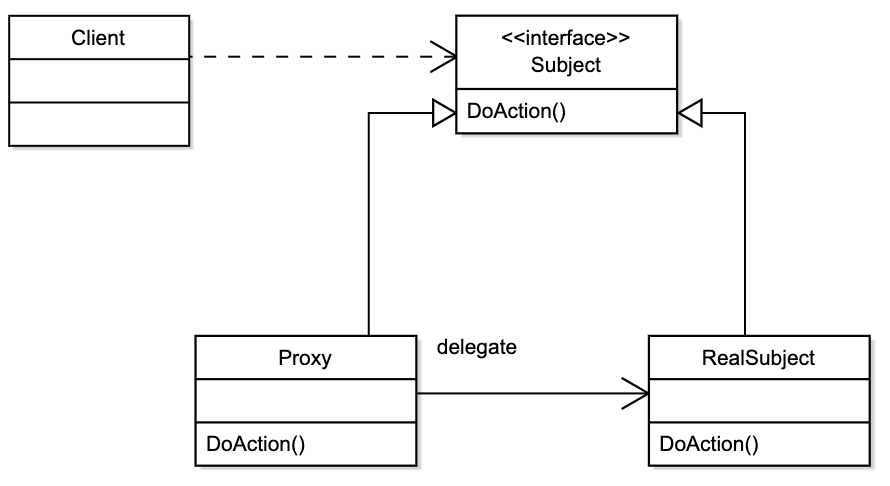Spring AOP - Proxy 기반의 AOP
스프링 AOP 특징
- Proxy 기반의 AOP 구현체
- Spring Bean에만 AOP를 적용할 수 있다.
- 모든 AOP 기능을 제공하는 것이 목적이 아니라 스프링 IoC와 연동하여 엔터프라이즈 애플리케이션에서 가장 흔한 문제에 대한 해결책을 제공하는 것이 목적이다.
Proxy 패턴의 사용 이유
- 기존 코드의 변경 없이 접근제어, 부가기능의 추가를 위하여 사용한다.

Proxy 기반의 AOP 예제
1. AOP를 사용하지 않는다면 …(crosscutting concern)
EventService.java
public interface EventService {
void createEvent();
void publishEvent();
void deleteEvent();
}
SimpleEventService.java
@Service
public class SimpleEventService implements EventService {
@Override
public void createEvent() {
System.out.println("Created an event");
}
@Override
public void publishEvent() {
System.out.println("Published an event");
}
@Override
public void deleteEvent() {
System.out.println("Deleted an event");
}
}
실행을 위한 AppRunner 작성
AppRunner.java
@Component
public class AppRunner implements ApplicationRunner {
@Autowired
EventService eventService;
@Override
public void run(ApplicationArguments args) throws Exception {
eventService.createEvent();
eventService.publishEvent();
eventService.deleteEvent();
}
}
위와 같은 Application이 있을 때
EventService의 createEvent, publishEvent 메서드의 실행 시간을 알고싶다면…?
SimpleEventService를 다음과 같이 수정할 수 있다.
@Service
public class SimpleEventService implements EventService {
@Override
public void createEvent() {
long beginTime = System.currentTimeMillis();
try {
Thread.sleep(1000);
} catch (InterruptedException e) {
e.printStackTrace();
}
System.out.println("Created an event");
System.out.println(System.currentTimeMillis() - beginTime);
}
@Override
public void publishEvent() {
long beginTime = System.currentTimeMillis();
try {
Thread.sleep(2000);
} catch (InterruptedException e) {
e.printStackTrace();
}
System.out.println("Published an event");
System.out.println(System.currentTimeMillis() - beginTime);
}
@Override
public void deleteEvent() {
System.out.println("Deleted an event");
}
}
위와 같이 프로그래밍 하는 것이 Crosscutting Concern이다 !
- 시간을 측정하는 코드가 메서드 사이사이에 중복되어 포함된다.
2. Proxy Pattern을 통한 해결
SimpleEventService.java
@Service
public class SimpleEventService implements EventService {
@Override
public void createEvent() {
System.out.println("Created an event");
}
@Override
public void publishEvent() {
System.out.println("Published an event");
}
@Override
public void deleteEvent() {
System.out.println("Deleted an event");
}
}
ProxySimpleEventService.java
@Primary
@Service
public class ProxySimpleEventService implements EventService {
@Autowired
SimpleEventService simpleEventService;
@Override
public void createEvent() {
long beginTime = System.currentTimeMillis();
simpleEventService.createEvent();
System.out.println(System.currentTimeMillis() - beginTime);
}
@Override
public void publishEvent() {
long beginTime = System.currentTimeMillis();
simpleEventService.publishEvent();
System.out.println(System.currentTimeMillis() - beginTime);
}
@Override
public void deleteEvent() {
simpleEventService.deleteEvent();
}
}
위와 같이 Proxy Class로 감싸 해결할 수 있다!
위의 방식의 문제점
- 매번 Proxy 클래스를 작성한다.
- 이러한 방법도 코드의 반복이 계속된다.
- 여러 클래스 여러 메소드에 적용하려면…?
- 모든 클래스에 Proxy 클래스를 만들어 중복된 코드를 심어야 한다.
- 객체들 관계가 복잡해진다.
- 위와 같은 방법은 컴파일시 AOP를 사용하는 방법이다.
그래서 등장한 것이 Spring AOP
- 스프링 IoC Container가 제공하는 기반 시설과 Dynamic Proxy를 사용하여 여러 복잡한 문제 해결하였다.
- Dynamic Proxy: 동적으로 Proxy 객체 생성하는 방법
- 자바가 제공하는 방법은 인터페이스 기반 Proxy 생성.
- CGlib은 클래스 기반 Proxy도 지원.
- 스프링 IoC: 기존 Bean을 대체하는 동적 Proxy Bean을 만들어 등록 시켜준다.
- 클라이언트 코드 변경이 없다.
- AbstractAutoProxyCreator (BeanPostProcessor의 구현체로 새로운 Bean Instance를 조작할 수 있는 기능을 제공)
- Bean Instance를 만든 이후 그 Bean을 감싼 AOP Proxy Bean을 만들어 주는 역할을 수행한다.
Spring - AOP (3) - @AOP 에서 계속…
Project Repository
- https://github.com/Seongmun-Hong/SpringStudy
Reference
- https://www.inflearn.com/course/spring-framework_core

